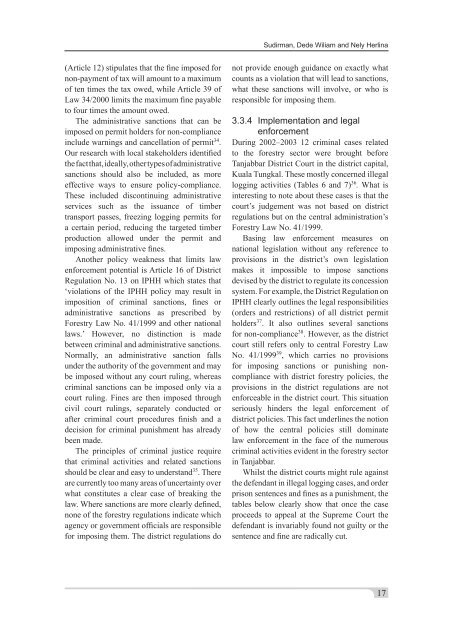Local policy-making mechanisms - Forest Climate Center
Local policy-making mechanisms - Forest Climate Center
Local policy-making mechanisms - Forest Climate Center
You also want an ePaper? Increase the reach of your titles
YUMPU automatically turns print PDFs into web optimized ePapers that Google loves.
Sudirman, Dede Wiliam and Nely Herlina(Article 12) stipulates that the fine imposed fornon-payment of tax will amount to a maximumof ten times the tax owed, while Article 39 ofLaw 34/2000 limits the maximum fine payableto four times the amount owed.The administrative sanctions that can beimposed on permit holders for non-complianceinclude warnings and cancellation of permit 34 .Our research with local stakeholders identifiedthe fact that, ideally, other types of administrativesanctions should also be included, as moreeffective ways to ensure <strong>policy</strong>-compliance.These included discontinuing administrativeservices such as the issuance of timbertransport passes, freezing logging permits fora certain period, reducing the targeted timberproduction allowed under the permit andimposing administrative fines.Another <strong>policy</strong> weakness that limits lawenforcement potential is Article 16 of DistrictRegulation No. 13 on IPHH which states that‘violations of the IPHH <strong>policy</strong> may result inimposition of criminal sanctions, fines oradministrative sanctions as prescribed by<strong>Forest</strong>ry Law No. 41/1999 and other nationallaws.’ However, no distinction is madebetween criminal and administrative sanctions.Normally, an administrative sanction fallsunder the authority of the government and maybe imposed without any court ruling, whereascriminal sanctions can be imposed only via acourt ruling. Fines are then imposed throughcivil court rulings, separately conducted orafter criminal court procedures finish and adecision for criminal punishment has alreadybeen made.The principles of criminal justice requirethat criminal activities and related sanctionsshould be clear and easy to understand 35 . Thereare currently too many areas of uncertainty overwhat constitutes a clear case of breaking thelaw. Where sanctions are more clearly defined,none of the forestry regulations indicate whichagency or government officials are responsiblefor imposing them. The district regulations donot provide enough guidance on exactly whatcounts as a violation that will lead to sanctions,what these sanctions will involve, or who isresponsible for imposing them.3.3.4 Implementation and legalenforcementDuring 2002–2003 12 criminal cases relatedto the forestry sector were brought beforeTanjabbar District Court in the district capital,Kuala Tungkal. These mostly concerned illegallogging activities (Tables 6 and 7) 36 . What isinteresting to note about these cases is that thecourt’s judgement was not based on districtregulations but on the central administration’s<strong>Forest</strong>ry Law No. 41/1999.Basing law enforcement measures onnational legislation without any reference toprovisions in the district’s own legislationmakes it impossible to impose sanctionsdevised by the district to regulate its concessionsystem. For example, the District Regulation onIPHH clearly outlines the legal responsibilities(orders and restrictions) of all district permitholders 37 . It also outlines several sanctionsfor non-compliance 38 . However, as the districtcourt still refers only to central <strong>Forest</strong>ry LawNo. 41/1999 39 , which carries no provisionsfor imposing sanctions or punishing noncompliancewith district forestry policies, theprovisions in the district regulations are notenforceable in the district court. This situationseriously hinders the legal enforcement ofdistrict policies. This fact underlines the notionof how the central policies still dominatelaw enforcement in the face of the numerouscriminal activities evident in the forestry sectorin Tanjabbar.Whilst the district courts might rule againstthe defendant in illegal logging cases, and orderprison sentences and fines as a punishment, thetables below clearly show that once the caseproceeds to appeal at the Supreme Court thedefendant is invariably found not guilty or thesentence and fine are radically cut.17

















